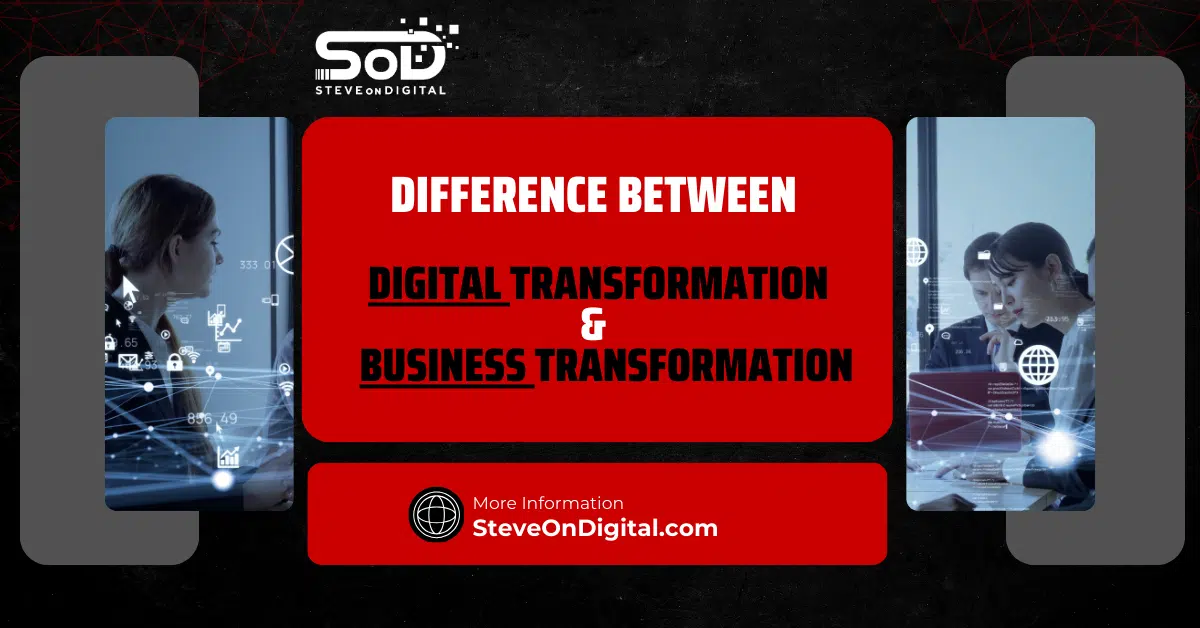A digital transformation framework is a plan for using digital technologies in all parts of a business. This process fundamentally changes how a business operates and delivers value to customers.
Digital transformation is essential in today’s fast-paced market. It helps businesses stay competitive and meet evolving customer expectations. The global market for digital transformation is projected to reach $3.4 trillion by 2026, highlighting its critical role in modern business strategies. Adapting to these changes is crucial for improving efficiency, enhancing customer satisfaction, and driving growth.
I’m Steve, a digital transformation expert with a strong background in electrical engineering, an MBA, and a master’s in Project Management. I excel at helping SMEs navigate the next digital technology landscape with practical insights. Let’s begin!
Understanding Digital Transformation
Digital transformation means using digital technology in every part of a business. It changes how the business works and how it serves customers, creating new ways of doing things.
Definition Of Digital Transformation
Digital transformation encompasses the adoption of digital technologies to improve processes, enhance customer experiences, and drive business growth. It includes technologies like cloud computing, data analytics, artificial intelligence, and more.
Importance Of Digital Transformation
The significance of digital transformation cannot be overstated. It offers numerous benefits, such as improved efficiency, enhanced customer satisfaction, and increased agility. For instance, businesses that embrace digital transformation are better positioned to respond quickly to market changes and customer demands.
Key Elements Of Digital Transformation
- Technology: Integrating new digital tools and platforms.
- Strategy: Developing a clear roadmap for digital initiatives.
- Culture: Fostering a culture that embraces change and innovation.
| Element | Description |
|---|---|
| Technology | Integrating new digital tools and platforms to enhance operations and services. |
| Strategy | Developing a clear roadmap for digital initiatives aligned with business goals. |
| Culture | Fostering a culture that embraces change and innovation, encouraging continuous improvement. |
Components Of A Digital Transformation Framework
A strong digital transformation framework that provides a structured approach to implementing digital changes.
Technology Integration
Successfully integrating new technologies into existing systems is crucial. This involves careful planning and execution to avoid disruptions and maximize benefits.
Strategic Planning
Having a solid strategy is vital for digital transformation. It should outline clear goals, objectives, and a timeline to guide the digital transformation process through.
Organizational Culture
A supportive organizational culture is essential. Encouraging a mindset open to change and innovation helps ensure the success of all digital transformation strategies and initiatives.
Change Management
Effective change management techniques are necessary to address resistance and ensure smooth transitions. This includes communication, training, and support to help business and it leaders and employees adapt to new technologies and processes.
Building a Digital Transformation Strategy
Creating a robust and effective digital transformation framework and strategy is a multi-step process that involves careful planning, resource allocation, and continuous evaluation. Here’s how I approach it, based on my experience and extensive research:
| Step | Description |
|---|---|
| Assessing Current State | Evaluating existing systems, processes, and technologies to understand their current capabilities and limitations. |
| Setting Goals And Objectives | Aligning digital transformation goals with the overall business strategy to ensure alignment with broader objectives. |
| Developing A Roadmap | Creating a detailed plan with manageable tasks and realistic timelines to guide digital transformation efforts. |
| Allocating Resources | Investing in the right technology, budget, and skilled personnel to support and sustain digital transformation initiatives. |
Assessing Current State
Before diving into digital transformation, it’s crucial to understand where your business stands. This means evaluating existing systems, processes, and technologies. Conduct interviews, surveys, and analyze documentation to identify pain points and areas for improvement. This assessment helps pinpoint what needs to change and sets a clear baseline for progress.
Setting Goals And Objectives
Setting clear, achievable goals is essential. Make sure your goals match your business plan so that digital changes help you reach your bigger goals. For instance, if your goal is to improve customer experience, you might aim to reduce response times using digital tools. Clear objectives help keep the digital transformation project focused and measurable.
Developing A Roadmap
A well-defined roadmap is your action plan. Break down your goals into manageable tasks with realistic timelines. Assign responsibilities and ensure everyone knows their role. This roadmap should be flexible enough to adapt to new challenges and opportunities but detailed enough to guide day-to-day activities.
Allocating Resources
Successful digital transformation requires the right resources. This includes budget, technology, and skilled personnel. Invest in training to upskill your team and ensure they’re equipped to handle new digital tools and processes. Allocate your budget wisely, focusing on technologies that offer the most significant impact and quick wins.
Implementing The Digital Transformation Framework
Implementation is where strategy meets action. Here are the best practices I follow:
Pilot Programs
Start with pilot programs to test and refine your approach. These small-scale projects help identify potential issues and opportunities without the risk of a full-scale rollout. Pilots also provide tangible results that can help gain buy-in from stakeholders.
Scaling Up
Once pilot programs prove successful, scale them up across the organization. This requires careful planning to ensure that the expanded implementation remains consistent and effective. Use lessons learned from pilot programs to improve the broader rollout.
Continuous Improvement
Digital transformation is an ongoing process. Regularly assess and refine your efforts to stay aligned with evolving business needs and technological advancements. Use data and feedback to drive continuous improvement and keep the digital transformation frameworks dynamic and relevant.
Tools And Technologies In Digital Transformation
Leveraging the right tools business models and technologies is vital for driving transformation:
| Technology | Benefits |
|---|---|
| Cloud Computing | Scalability, flexibility, cost-efficiency. Supports efficient data storage and processing. |
| Data Analytics | Informed decision-making, understanding customer behavior, process optimization. |
| Artificial Intelligence (AI) | Automating tasks, enhancing decision-making, personalizing customer experiences. |
| Mobile Technologies | Enhancing accessibility and engagement, providing seamless customer experiences across devices. |
Cloud Computing
Cloud computing offers scalability, flexibility, and cost-efficiency. It enables businesses to store and process data efficiently, supporting everything from everyday operations to innovative new services. According to Gartner, by 2026, global cloud spending is expected to reach $832 billion (Digital Adoption).
Data Analytics
Data analytics is crucial for informed decision-making. It helps businesses understand customer behavior, optimize processes, and uncover new opportunities. Implementing advanced analytics can drive significant improvements in efficiency and customer satisfaction.
Artificial Intelligence And Machine Learning
AI and ML are changing how businesses work. They help by doing tasks automatically, making better decisions, and giving customers personalized experiences. These technologies can transform everything from customer service to supply chain management (Digital Leadership).
Mobile Technologies
Mobile technologies enhance accessibility and engagement. With the rise of mobile usage, having a robust mobile strategy is essential for reaching customers and providing seamless experiences across devices.
Measuring Success In Digital Transformation
Evaluating the success of digital transformation initiatives is crucial to understanding their impact and ensuring that they meet business goals. Here’s how I approach this process, supported by key performance indicators (KPIs), customer feedback, and benchmarking against industry standards.
Key Performance Indicators (KPIs)
KPIs are vital for measuring progress and success. They should be clearly defined, achievable, and directly tied to business outcomes. Common KPIs include:
- Return on Digital Investments (ROI): This measures the financial returns from digital transformation initiatives compared to the costs involved. It helps determine if the investments are delivering the expected value over time.
- Employee Productivity: New technologies should enhance employee productivity. Track metrics such as the time saved on tasks or the number of tasks completed within a set period.
- Adoption and Performance Metrics: These include daily/monthly active users, adoption rates, and average time spent using a product or feature. These metrics indicate how well employees and customers are engaging with new digital tools (Whatfix) (Docsumo).
Customer Feedback
Customer feedback is a direct measure of the success of digital transformation efforts. Important metrics include:
- Customer Satisfaction (CSAT): Surveys and feedback forms can help measure how satisfied customers are with new digital services.
- Net Promoter Score (NPS): This score indicates how likely customers are to recommend your service to others, providing insight into customer loyalty and satisfaction.
- Customer Effort Score (CES): This measures how much effort customers have to put in to interact with your business, with lower effort indicating a better experience (Docsumo) (Brightspot).
Benchmarking and Analysis
Benchmarking involves comparing your performance metrics against industry standards to identify areas of strength and improvement. Key steps include:
- Pre and Post-Transformation Data Comparison: Analyzing data from before and after digital transformation initiatives helps identify their impact on KPIs.
- Regular Assessments: Conducting regular assessments and using data analytics tools to track progress helps in maintaining alignment with business goals.
- Industry Benchmarks: Comparing your KPIs with industry standards can highlight competitive positioning and areas needing attention (Whatfix) (Gartner).
Overcoming Challenges In Digital Transformation
Digital transformation is not without its challenges. Here are some common obstacles and strategies to overcome them:
Resistance to Change
Resistance to change is a significant barrier. Overcoming it involves:
- Effective Communication: Clearly communicate the benefits of digital transformation to all stakeholders.
- Involvement and Training: Engage employees early in the process and provide adequate training to ease the transition (McKinsey & Company) (Brightspot).
Legacy Systems
Legacy systems can be a hurdle. Strategies include:
- Incremental Integration: Gradually integrating new technologies with existing systems to minimize disruptions.
- Phased Replacement: Replacing legacy systems in phases to ensure smooth transitions and continuity (Brightspot).
Skill Gaps
Digital transformation often requires new skills. Addressing skill gaps involves:
- Training Programs: Implementing comprehensive training programs to upskill the workforce.
- Hiring Specialized Talent: Recruiting experts with the necessary skills to drive digital initiatives (Docsumo) (Gartner).
Case Studies Of Successful Digital Transformations
Real-world examples provide valuable insights into successful digital transformations:
Case Study 1: Company A
Company A successfully implemented a digital transformation strategy that improved customer experience and operational efficiency. Key takeaways include the importance of a clear digital maturity roadmap and robust change management practices.
Case Study 2: Company B
Company B leveraged digital age emerging technologies to streamline its processes and enhance employee productivity. Lessons learned highlight the significance of continuous improvement and the need for ongoing assessment of digital initiatives (McKinsey & Company) (Gartner).
Future Trends In Digital Transformation
Digital transformation continues to evolve, driven by emerging technologies and shifting market demands. Here’s a look at the latest trends emerging technology, that will shape the landscape in 2024 and beyond:
IoT (Internet of Things)
The Internet of Things (IoT) remains a pivotal force in digital transformation. IoT devices enable real-time data collection and communication between systems, leading to smarter, more efficient operations. For instance, IoT in manufacturing allows for predictive maintenance, reducing downtime by alerting operators to potential equipment failures before they occur. This not only enhances operational efficiency but also improves customer satisfaction by ensuring timely delivery of products (Sify).
Blockchain Technology
Blockchain technology extends beyond cryptocurrencies. In 2024, businesses are leveraging blockchain for secure transactions, transparent supply chains, and enhanced data integrity. For example, blockchain can create unalterable records of product journeys, enhancing trust in supply chain management. Additionally, digital identities secured by blockchain technology reduce the risk of identity theft, providing individuals control over their personal information (Lanars LLC).
Augmented Reality (AR) And Virtual Reality (VR)
AR and VR are revolutionizing how businesses interact with customers and train employees. In retail, AR enables customers to visualize products in their own space before purchase, enhancing the shopping experience. In the corporate world, VR provides immersive training environments, allowing employees to practice skills in a virtual setting, leading to better retention and performance (IBM – United States) (Sify).
Digital Transformation And Customer Experience
Digital transformation significantly enhances customer experiences by leveraging data and technology to meet and exceed customer expectations.
Personalization
Using digital tools, businesses can deliver highly personalized experiences. Data analytics and AI enable companies to understand customer preferences and behavior, allowing for tailored recommendations and offers. This level of personalization increases customer loyalty and satisfaction (Gartner).
Omni-Channel Strategies
An omni-channel strategy ensures customers receive a consistent experience across all touchpoints, whether online, in-store, or through mobile apps. Integrating these channels provides a seamless transition for customers, enhancing their overall experience and engagement with the brand (Lanars LLC).
Customer Engagement
Digital transformation tools, such as chatbots and social media platforms, provide new ways to engage with customers. These tools offer instant responses and support, improving customer service and satisfaction. Moreover, interactive content like videos and webinars keeps customers engaged and informed about products and services (Sify).
The Role Of Leadership In Digital Transformation
Leadership plays a pivotal role in guiding and supporting digital transformation efforts. As I have navigated these waters, I’ve learned that successful digital transformation hinges not just on technological advancements but equally on astute leadership. Here’s a deep dive into how leadership drives successful digital transformation framework:
Visionary Leadership
A clear vision is crucial for any transformation initiative. Leaders must articulate a compelling vision that aligns with the organization’s goals and resonates with stakeholders. This vision acts as a guiding light, rallying employees behind a shared purpose. It’s about setting a course that others can follow, helping to navigate the uncertainties and complexities that come with implementing digital transformation together. For instance, when I embarked on my digital transformation journey, having a clear roadmap helped keep everyone focused and aligned with our strategic objectives (McKinsey & Company) (World Economic Forum).
Empowering Teams
Empowering teams is essential for driving digital transformation. Leaders need to foster a culture of adaptability, agility, and innovation. This involves encouraging a mindset where experimentation is welcomed, and learning from failures is seen as a path to improvement. In my experience, providing the right resources and support, and breaking down silos to foster cross-functional collaboration, have been key to empowering my teams to achieve our digital transformation goals (Deloitte United States) (Trigyn).
Decision-Making
Strategic decision-making is at the heart of successful digital transformation. Leaders must make informed decisions about technology adoption, investments, and resource allocation. It’s about discerning which technologies align best with the organization’s objectives and ensuring adequate investment in infrastructure and talent. Effective business leaders will also need to manage change adeptly, guiding their teams through the transformation process and instilling resilience within the workforce (World Economic Forum) (HR Executive).
Industry-Specific Digital Transformation
Digital transformation impacts various industries differently. Here’s how it manifests in specific sectors:
Healthcare
In healthcare, digital transformation enhances patient care through technologies like telehealth, electronic health records (EHRs), and AI-driven diagnostics. These advancements improve patient outcomes, streamline operations, and reduce costs. For example, during the pandemic, many healthcare providers rapidly adopted telehealth solutions to continue providing care safely (Deloitte United States).
Finance
In the financial sector, digital transformation is reshaping services through fintech innovations, blockchain technology, and AI. These technologies enhance transaction security, improve customer service, and streamline operations. Financial institutions that embrace these changes can offer more personalized and efficient services to their clients (McKinsey & Company).
Retail
Retail has been significantly impacted by digital transformation, with e-commerce, data analytics, and personalized marketing becoming central to operations. Retailers use digital tools to enhance customer experiences, optimize supply chains, and implement omnichannel strategies that provide a seamless shopping experience across various platforms (Trigyn).
Final Thoughts
In summary, leadership is the linchpin of successful digital transformation. It’s because digital transformation revolves about more than just adopting new technologies; it’s about orchestrating a strategic, cultural, and organizational shift. Leaders who effectively champion digital transformation inspire, empower, and guide their teams toward a future where innovation and adaptability are key. As technology continues to evolve, the role of leadership in driving digital transformation remains paramount in shaping the future landscape of businesses across industries (World Economic Forum) (Deloitte United States) (HR Executive).




